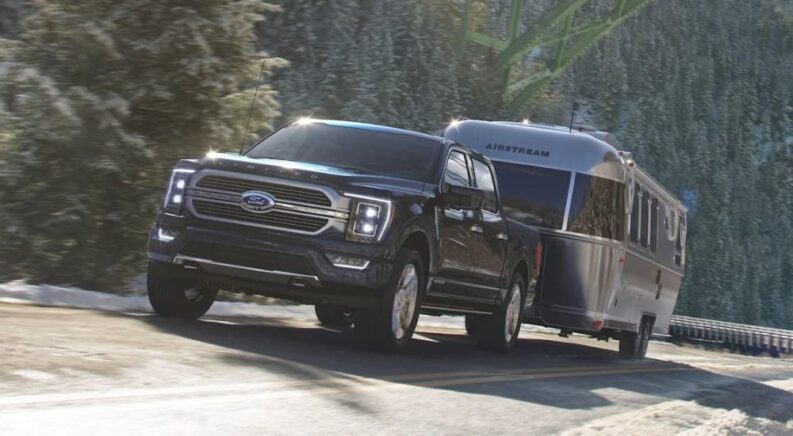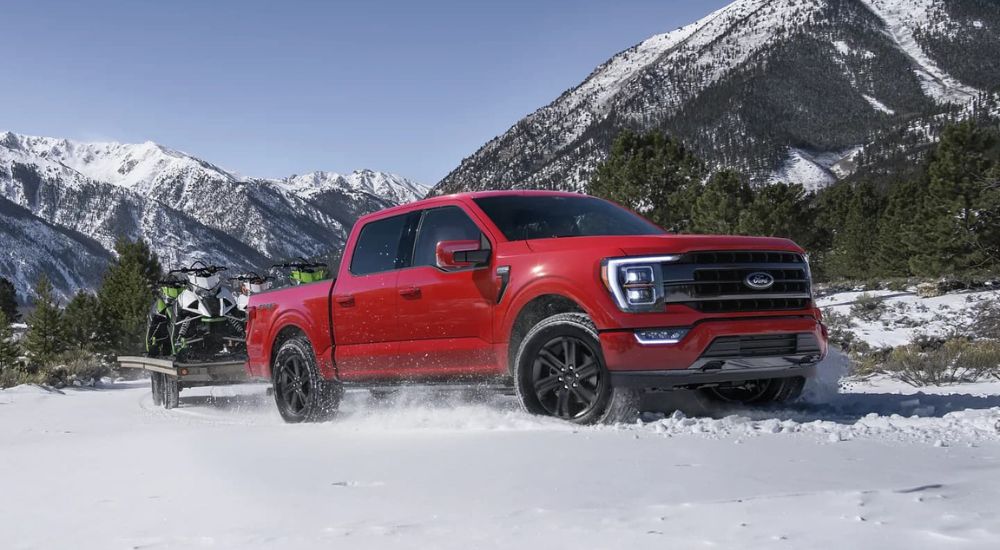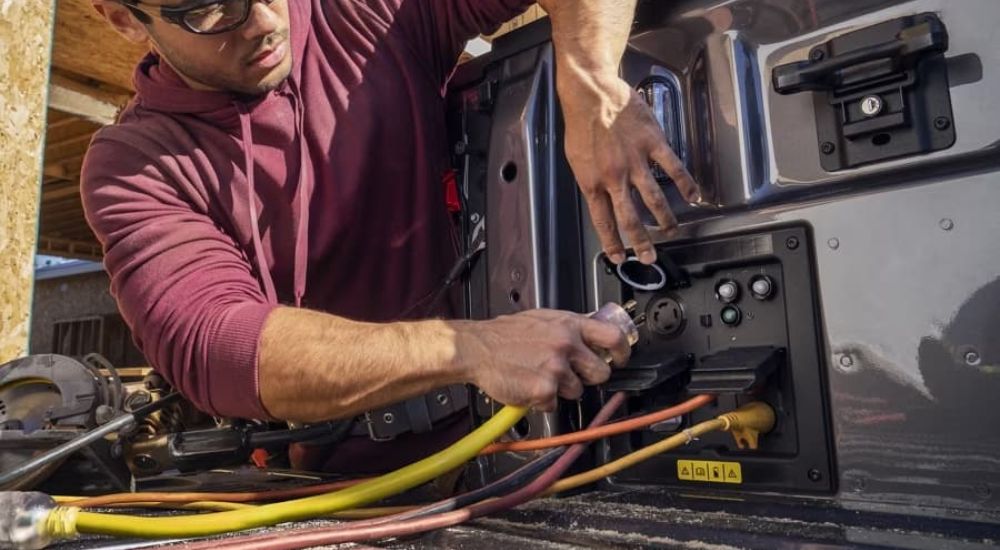Fuel economy has never been the pickup segment’s strong suit, but it’s been on an upward trend over the past few decades. Take the Ford F-150, for example. America’s best-selling truck has come a long way since the mid-1980s, upping its average miles-per-gallon by a significant margin as the automaker continues to perfect its engines with new technology and designs. Packed with a 5.0L V8 engine, the 1985 F-150 delivered 14 MPG in the city and just 17 MPG on the highway. Those figures increased to 20 MPG on the highway for the 1997 F-150 powered by a 4.6L V8, but there was still room for improvement. By 2015, the F-150’s V8 was offering 15 MPG in the city and 22 MPG on the highway—but the newest version takes it to the next level with a 5.0L V8 enabling an unrivaled 17 MPG in the city and 24 MPG on the highway.
Most impressively, this has all been accomplished with a reduction in overall power. Take a quick look at a Ford F-150 for sale and you’ll notice that this pickup has simultaneously become more efficient and powerful over the last 30-plus years. While the 1985 model delivered a then-standard 185 hp, that number rose to 231 by 1997 and 385 in 2015. The 2023 F-150, which marks the third year of the award-winning pickup’s 14th generation, ups the bar once again with 400 hp and 410 lb-ft of torque to play with. It’s not the most efficient choice in the lineup, but for those seeking a work-ready truck with a payload rating of 3,310 lbs, it’s hard to beat.
All told, the F-150 has gained 215 hp along with an average 3-MPG city and 7-MPG highway increase in fuel economy over the last 38 years—and that’s just the V8. Ford is rolling out a generous lineup of engines for 2023 with six different options to choose from, if one includes the new all-electric F-150 Lightning. Join us as we take a closer look at the F-150 engines on offer for 2023, see how they compare in terms of fuel economy and power, and see how Ford has managed to maintain such a consistent upward trajectory in overall efficiency.
Building a Better Engine
So how has Ford managed to improve both the F-150’s horsepower and fuel efficiency over the last four decades? It all comes down to a never-ending commitment to innovation. Ford hasn’t become one of the biggest names in the industry by resting on its laurels; they’ve never been afraid to take chances, pioneering new techniques and practices that have seen the company grow from a single converted factory in Detroit to the $48-billion behemoth it is today. Ford was one of the first major automakers to experiment with port fuel injection in the mid-1980s, giving the brand a significant leg up over the competition, who were largely still tinkering with the throttle body concept. Port fuel injection allowed Ford engineers to max out the F-150’s power, with the ’85 V8 producing some 185 hp along with 270 lb-ft of torque.
The next big leap would be the introduction of modular or “mod” overhead cam technology for Ford’s lineup of V8 engines. First debuting on the 1991 Lincoln Town Car, the mod design would replace the engine’s pushrod-powered forerunners and allow Ford to squeeze more power than ever out of the engine while also reducing fuel consumption and overall cost. The modular engine was all about flexibility, allowing designers to optimize the location, size, and shape of the exhaust and intake ports, which increases airflow and, in turn, power and fuel economy. The same 4.6L two-valve single overhead camshaft (SOHC) V8 found in the 1991 Lincoln would eventually make its way into the 1997 F-150, giving drivers more power than the pickup’s outgoing V8 despite having a smaller displacement.
Today, hybrid powertrains represent the latest and greatest in F-150 engine design. Debuting on the 2021 model, the PowerBoost engine combines a 3.5L V6 with an electric motor to give the F-150 its first-ever hybrid powertrain. This setup delivers an impressive 7-MPG city and 2-MPG highway bump to the pickup’s overall efficiency, making the hybrid an alluring option for drivers looking to save a little money at the pump. Then, of course, there’s the Lightning. While it might seem unfair to compare the new all-electric version of Ford’s popular pickup with its gas-powered cousins, it goes a long way in illustrating how the model has evolved over the years. With 452 hp—or 580 hp with the Extended Range battery—and an MPG-equivalent (MPGe) of 76 in the city and 61 on the highway, the F-150 Lightning represents an exciting new direction for the storied pickup.
2023 Engine Lineup
Serving as the base engine for the F-150 entry-level XLT trim, the 3.3L Ti-VCT V6 delivers solid performance thanks to its innovative design. This engine was designed with a novel air intake system, and the twin independent variable camshaft timing (Ti-VCT) allows the V6 to deliver consistent power by tailoring the opening and closing of its valves to meet the pickup’s operating conditions. Add in a port-fuel direct-injection (PFDI) system with two injectors per cylinder, and you’ve got a brawny V6 that punches well above its weight with 290 hp and 265 lb-ft of torque while still offering an economical 19 MPG in the city and 24 MPG on the highway.
The F-150’s 5.0L Ti-VCT V8 takes everything there is to love about the V6 version and kicks it up a notch. Featuring both Ti-VCT and PFDI technology, the eight-cylinder beast should give you all the power you need for even the toughest towing and hauling jobs with 400 hp and 410 lb-ft of torque under the hood. That’s good enough to earn the V8 a maximum payload rating of 3,310 lbs—and the second-best towing capacity of the bunch—though it’s a bit thirstier than some of the other engines on offer with fuel economy rating of 17 MPG in the city and 24 MPG on the highway.
Ford’s EcoBoost technology has kept the F-150 competitive in an ultra-competitive market, delivering an ideal mix of power and efficiency that’s won over its fair share of drivers. It’s all thanks to the engine’s twin intercooled turbochargers, which allow drivers to summon all the power they need at a moment’s notice. With 325 hp and 400 lb-ft of torque, the 2.7L EcoBoost V6 allows drivers to take advantage of the F-150’s towing and hauling capabilities without having to spend too much time searching for a gas station. The V6 is the most economical option of the purely gas-powered lineup with 20 MPG in the city and 26 MPG on the highway.
As perhaps the most well-rounded engine in the current lineup, the 3.5L EcoBoost V6 doesn’t ask drivers to sacrifice power in the name of efficiency. Packed with the same twin intercooled turbochargers as the 2.7L version, this EcoBoost V6 offers unrivaled towing performance with a maximum available rating of 14,000 lbs thanks to its considerable 500 lb-ft of torque and 400 hp. This engine is also rather thrifty at 18 MPG in the city and 24 MPG on the highway, although the high-output version designed to power the F-150 Raptor sees those numbers cut to 14 MPG in the city and 18 MPG on the highway. There’s good reason for the downgrade: with 450 hp and 510 lb-ft of torque, the souped-up version is a little too preoccupied with powering the desert racing-inspired Raptor to concern itself with something as trivial as fuel economy.
The engine of the future is here, and it leaves very little to be desired. Blending the best aspects of gas and electric powertrains, the 3.5L PowerBoost V6 full-hybrid setup combines a 3.5L twin-turbo V6 with a 35 kW electric motor to give drivers 430 hp and 570 lb-ft of torque. As one would expect from a hybrid engine, it’s also exceedingly efficient, with a single tank of gas lasting up to 700 miles. At 25 MPG in the city and 26 MPG on the highway, this full-hybrid V6 makes the F-150 one of the greenest pickups on the market—but the engine still has one more trick up its sleeve. Thanks to Ford’s Pro Power Onboard technology, this PowerBoost engine can double as a mobile generator, giving you 2.0-, 2.4- and 7.2-kW connections to charge any equipment you might need for a successful day on the job or a weekend camping adventure.
While the Lightning is technically a standalone model, we thought we would include its engine in this list to show just how far Ford has come over the years. This all-electric pickup has proved immensely popular on its debut, with drivers claiming these cutting-edge pickups almost as soon as they hit the dealer’s lot. Given its electric setup, the Lightning can be judged by the size of its battery packs rather than something as old-fashioned as an engine. This pickup produces some 454 hp when equipped with the Standard Range battery and 580 hp if you opt for the Extended Range option. Both batteries provide a mind-blowing 775 lb-ft of torque, which might lead you to ask the question, “How much can it tow?” The answer? A lot. At a staged press event showcasing a concept version of the EV pickup, the Lightning towed a 1,000,000-lb train packed with F-150s. (The production version, however, is rated at a relatively paltry 10,000 lbs.) As far as efficiency is concerned, the Lightning technically gets “infinite” miles to the gallon, although—by MPGe standards—it’s more along the lines of 78 MPGe in the city and 63 MPGe on the highway for the Extended Range version and 76 MPGe in the city and 61 MPGe on the highway for the Standard Range.
Innovation Is Power
Whether you’re looking for a powerful work truck, a reliable daily driver, or a feature-packed family vehicle, the 2023 Ford F-150 has you covered. This legendary pickup has remained at the top of the US sales charts for almost 40 years, and with good reason: the F-150 has earned a reputation for dependability, power, and efficiency that few others in this sector can match. The current engine lineup goes a long way in illustrating just how adaptable this humble truck can be.
From its thrifty EcoBoost options to the tow-ready Ti-VCT V8, the F-150 truly runs the gamut in powertrains. New options like the PowerBoost hybrid and the F-150 Lightning’s all-electric setup are bringing something new to the table, giving drivers the same performance they’ve come to expect while taking a drastically smaller toll on their wallets and the environment. The latest iteration of the F-150 proves that Ford is always looking towards the future, continually improving upon a classic to keep the F-150 at the top of the mountain in an ever-changing market.






